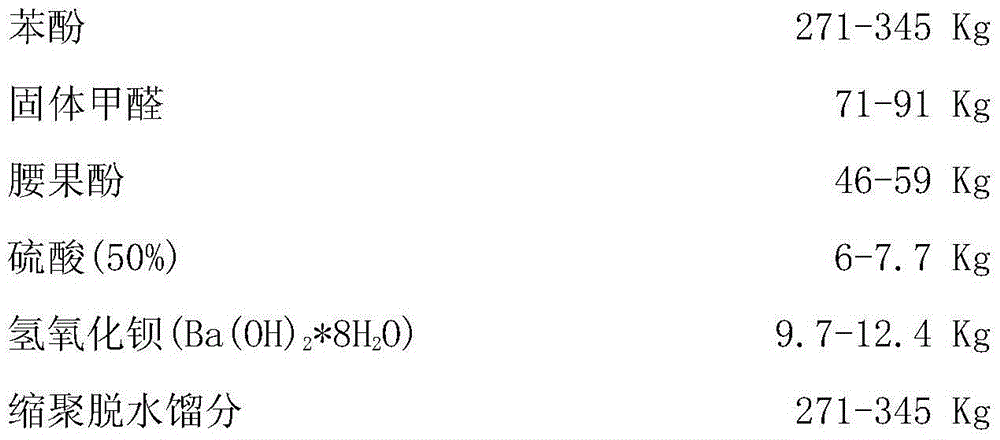Process for circularly producing thermoplastic barium sulfate phenolic resin by precipitation method
A technology of phenolic resin and barium sulfate, which is applied in the field of cyclic production of thermoplastic barium sulfate phenolic resin by precipitation method, can solve problems such as difficult to achieve satisfactory treatment effect, slow down reaction speed, affect product preservation, etc., and achieve environmental protection and avoid waste water produce good economic benefits
- Summary
- Abstract
- Description
- Claims
- Application Information
AI Technical Summary
Problems solved by technology
Method used
Image
Examples
Embodiment 1
[0028] Embodiment 1: prepare thermoplastic barium sulfate phenolic resin
[0029] Preparation of thermoplastic barium sulfate phenolic resin formula can be in the following ranges:
[0030]
[0031] Start the stirring of a 1000-liter reactor with condenser, agitator, quick opening, jacketed steam heating and water cooling, add 250Kg of phenol, 65Kg of solid formaldehyde, 250Kg of polycondensation dehydration fraction or deionized water, and heat to 50-80 After the formaldehyde is depolymerized at ℃, slowly add 1Kg of sulfuric acid (50%), and carefully raise the temperature to reflux. After the reaction is gentle, slowly add the remaining 2Kg of sulfuric acid (50%) and then reflux for 1 hour to sample. The sample is at 20 When the water is not sticky and hard, the jacket is cooled to a material temperature of 96°C, and barium hydroxide (Ba(OH) 2 *8H 2 O) 4.8Kg neutralizes sulfuric acid, terminates the catalytic reaction, generates barium sulfate precipitate and water, then...
Embodiment 2
[0032] Embodiment 2: the preparation of low cardanol thermoplastic barium sulfate phenolic resin
[0033] Recipes can be in the following ranges:
[0034]
[0035] Start the stirring of a 1000-liter reactor with condenser, agitator, quick opening, jacketed steam heating and water cooling, add 345Kg of phenol, 91Kg of solid formaldehyde, 59Kg of cardanol, 345Kg of polycondensation dehydration fraction, and heat to 50-80 After the formaldehyde is depolymerized at ℃, slowly add 2.3Kg of sulfuric acid (50%), and carefully raise the temperature to reflux. After the reaction is gentle, slowly add the remaining 5.4.Kg of sulfuric acid (50%) in two times and then reflux for 1 hour to sample. When the sample is not sticky and hard in 20°C water, the jacket is cooled to a material temperature of 95-96°C, and barium hydroxide (Ba(OH)) is added slowly. 2 *8H 2 O) 12.4Kg neutralizes sulfuric acid, terminates the catalytic reaction, generates barium sulfate precipitate and water, and t...
Embodiment 3
[0036] Embodiment 3. Preparation of high cardanol thermoplastic barium sulfate phenolic resin
[0037] Recipes can be in the following ranges:
[0038]
[0039] Start the stirring of a 1000-liter reactor with condenser, agitator, quick opening, jacketed steam heating and water cooling, add 220Kg of phenol, 65Kg of solid formaldehyde, 72Kg of cardanol, polycondensation dehydration fraction and 220Kg of deionized water, and turn on steam heating After the formaldehyde is depolymerized at 50-80°C, slowly add 2Kg of sulfuric acid (50%), and carefully raise the temperature to reflux. After the reaction is gentle, slowly add the remaining 6Kg of sulfuric acid (50%) in two times and then reflux for 1 hour to sample , when the sample is not sticky and hard in 20°C water, the jacket is cooled to a material temperature of 96°C, and barium hydroxide (Ba(OH) 2 *8H 2O) 4.8Kg neutralizes sulfuric acid, terminates the catalytic reaction, generates barium sulfate precipitate and water, a...
PUM
 Login to View More
Login to View More Abstract
Description
Claims
Application Information
 Login to View More
Login to View More - R&D
- Intellectual Property
- Life Sciences
- Materials
- Tech Scout
- Unparalleled Data Quality
- Higher Quality Content
- 60% Fewer Hallucinations
Browse by: Latest US Patents, China's latest patents, Technical Efficacy Thesaurus, Application Domain, Technology Topic, Popular Technical Reports.
© 2025 PatSnap. All rights reserved.Legal|Privacy policy|Modern Slavery Act Transparency Statement|Sitemap|About US| Contact US: help@patsnap.com



